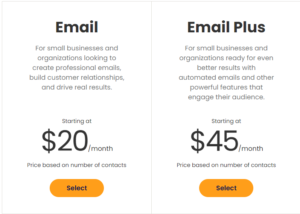Conatant Contact Review:Whether automation, Personalization, and Product Features

Constant Contact Review
Constant Contact is an impressive blend of functionality and usability. It’s easy to set up and quick to get up and running, with a tailored approach that makes it suitable for marketers of all experience levels, including people who have never used email marketing software before or aren’t familiar with industry concepts. Constant Contact excels in its contact management capabilities, but it’s lacking in areas such as segmentation, while the price may be off-putting for marketers with limited budgets.
Introduce
When are email marketing tools not email marketing tools? When it expands its feature set to cover more than just email marketing.
Constant Contact was originally born as a pure email marketing solution, but then it followed competitors such as Mailchimp and expanded into advertising, such as Google and Facebook ads.
Since 1995, Constant Contact has been participating in the email marketing game. During this period, they have successfully become one of the most used email tools in the world, with more than 650,000 customers.
The email provider belongs to a large group of digital tools called EIG, which includes brands such as Bluehost, HostGator, and Web.com. One thing I noticed is that Constant Contact is usually the first choice for many other review sites. In previous tests on the EIG brand, our reviewers found that most of the time their marketing was stronger than the actual product. Of course, I am curious whether this is also the case here.
What sets them apart is that they have added features that are rarely used by competitors over the years, such as digital product downloads, event management, appointment scheduling, and social activities. In addition to automation and regular communication, these are added to the list of various email options available.
Constant Contact has a market with approximately 400 applications and integrations that can meet even the most segmented product needs. However, despite these flashy numbers and features, interest in Constant Con
tact seems to be declining, at least according to Google Trends. There are enough reasons for us to carefully study the ins and outs of Constant Contact and check whether it is still relevant in the 21st century.
Who is the object of continuous contact?
Although Constant Contact has many advanced features—namely, reporting and contact management—but they are easy to understand and use. Therefore, even if you don’t have email marketing experience, you can quickly get to know this email marketing software and start using it, while feeling that you are taking full advantage of all the features.
Constant Contact is geared towards small businesses, but their prices are relatively affordable. Plans start at $20 per month, and the lowest plan allows 500 subscribers.
Feature: Usability
Constant Contact is one of the easiest email marketing services we reviewed, and the email editor is excellent. Even if you have never designed an email, the editor will automatically clean up your website to find your logo, colors, and social media profiles. Once you have this information, you can easily customize the template to create attractive emails. There are dozens of templates to choose from, and we like to save our favorite templates to quickly reuse them when creating new emails.
Constant Contact integrates with a variety of other services, such as Excel, Salesforce, Outlook, and list building tools, allowing you to easily synchronize contacts and other data, and more. Constant Contact allows users to integrate with Vimeo. This strategic partnership allows email marketers to create, host, and manage videos within the Constant Contact platform. Users can create videos, embed GIFs, capture and synchronize leads, and measure the video effects of any given event.
In addition, Constant Contact’s automated service allows you to send automated emails triggered by customer actions, so when consumers are interested in your products or services, you will respond.
Price and Recommendation
Constant Contact has two email marketing plans, Email and Email Plus, which can meet the budgets of most small businesses. Both plans contain everything needed to create a professional email campaign. For each plan, you can send unlimited emails. Each plan comes with customizable templates, contact management and list building tools, pop-up forms, tracking and reporting functions, image libraries, and mobile applications.
Prices for both plans are based on the size of the list. If you prepay for six months, you will get a 10% discount; if you prepay for 12 months, you will get a 15% discount. Non-profit organizations can enjoy additional discounts and provide special programs for franchisees and associations.
Email plans: Email plans start at US$20 per month (up to 500 subscribers) and US$65 (up to 5,000 contacts). The most expensive package is US$335 and supports 50,000 contacts.
Email Plus plan: Email Plus adds a dynamic registration form, 2GB of file storage space, access rights for up to 10 users, email automation, event marketing, online donations, surveys, and coupons. The cheapest package of the Email Plus plan is $45 per month, and you can send emails to up to 500 contacts. For 2,500 contacts, the cost is $70 per month. For 50,000 contacts, the most expensive package is $335.
If you have more than 50,000 subscribers, you need to contact Constant Contact for a quote. If your contact list changes from one billing cycle to the next, Constant Contact will automatically adjust your charges.
Constant Contact offers a free 60-day trial with all Constant Contact tools, including templates, images, email editor, contact management, reports, and real-time support. However, with the free trial, your maximum number of contacts is 100.
Form Details
| criterion | rating | comments |
|---|---|---|
Ease of Use | Generally it’s easy to navigate, though a bit dull-looking. You can get to most places within a couple of clicks, though as they’ve added more functionality, some things have become a little hidden, for example, automations. | |
Newsletter Creation | ||
| The editor is fast, but light on features, especially in the styling department. Apart from that it’s easy to work with. | |
|
| This is very basic, only allowing you to insert simple greetings or contact details. There is no if/then/else logic available. |
Generally, there are different types of campaigns available: Single campaigns (broadcast emails), timed newsletters, autoresponders, A/B-testing, RSS and follow-up emails. More information here. “> | Classic, autoresponders, basic automations, recurring newsletters, A/B testing, event registrations, coupons, surveys and polls. | |
| Not bad. There are around 200 (!) templates to choose from, with varying degrees of quality (some are decent, while others look a little basic and dated). You can also start from scratch, and use a handy feature called ‘Brand your email’ to auto-generate a template based on your website’s colors and logo. | |
Email automation allows you to set up workflows. You can, for example, trigger automatic actions based on the click behavior of your recipients. With this you can send out follow-up emails and tag people. Find more information here. “> | They offer autoresponders and abandoned cart campaigns for Shopify and WooCommerce. It also generates pre-defined contact segments based on your customers’ interactions with your online store (e.g. repeat, lapsed and potential customers). Automations based on contact triggers (e.g. email opens, clicks) are also available. It’s worth noting that the automations aren’t the most flexible, as you can’t really combine conditions and actions as you can in many other tools. | |
List Management | You can create segments from contact activity, list membership, contact details, tags, or ecommerce activity. You can also create a segment from your contact insights and tag contacts based on contact field criteria. | |
The standard, and most common, these days is Double opt-in registration, where the recipient receives a confirmation email with a link inside. They must click on this link in order to actually join the mailing list. More information. “> | There is next to no customization with the form, and it simply offers a description box, basic field options (which you can’t add to) and then a list, or lists, that people can check to be added to. | |
| As you can see in our deliverability tests, Constant Contact does not perform too badly, reaching the most popular email providers (AOL, Gmail, Yahoo, and Outlook) the majority of the time. | |
Reports and Analysis | In addition to standard open and click reports, spam, bounce and unsubscribe rates are also available. You also get click heat maps, and some useful overview reports such as open and click trends, opens by device, % of contacts engaged, and most successful subject line. You can also compare campaigns. However, advanced tracking such as social tracking isn’t available. | |
Languages | Here’s where it gets a bit hairy. The site and the tool are only available in English. You can choose to change some of the non-editable email sections (e.g. footer and privacy policy text) to one of 10 languages available, mostly European. Support and the knowledge base is available in 4 languages. Slightly confusing, but at least there’s some effort to support multilingual users and audiences. | |
Further Features | ||
| Spam testing isn’t available, however, there is a feature to check the email for errors (missing links, placeholder text that hasn’t been updated, etc.). There’s also a tool that allows you to preview how emails will look for specific recipients, although this didn’t seem to work when we tested it out. ‘Inbox Preview’ by Litmus is available as an add-on service, although at $10/month for just 5 tests, it’s a little steep. | |
|
| Soft bounces are placed on temporary hold for 15 days, and then resent. If it happens again, they are moved into a suspended bounce category. They have a ‘recommended for removal’ filter available to view these, but don’t remove them automatically. |
|
| Import/export available although it’s not as straightforward as it could be – you need to first enable advanced email permissions under Account Settings. |
Storage available for data and images | Unlimited | All plans come with unlimited storage. |
Pro Features | ||
There are several types of authentication: SPF (Sender Policy Framework), Sender ID, Domain Keys, and DKIM. These methods all cause the sender of an email to be listed in the domain settings as an authorized sender. For more information, check this article. “> |
| SPF and DKIM are supported. |
|
| |
|
| The Account Owner can also assign roles to be either an Account Manager or a Campaign Creator. |
Integrations |
| Constant Contact offer a massive amount of apps and integrations, almost 400. |
|
| This is only available via their form builder, and it’s very basic. Instead, we’d recommend these free landing page builders. |
Support | 3.5/5 | There are several channels of support, including live chat, phone support, a knowledge base and community-based support. However, I found that the chat and phone support weren’t always available, which was a little frustrating. When I was able to get hold of chat support, however, I did find them to be responsive and useful. Bear in mind that you’ll need to call in order to cancel your subscription, which is pretty annoying. |
Overall rating | 3.6/5 | For a basic email tool, Constant Contact ticks most of the boxes. The main issue here, though, is that they’re asking a premium price for a sub-premium product. |
Summarize:
We recommend continuing to contact:
Small and medium enterprises looking for affordable marketing solutions.
Companies that want to try new email marketing services without risk.
Companies that want to integrate email marketing with other e-commerce or social media platforms.
We do not recommend using continuous contact for:
Businesses with more than 50,000 email contacts.
Businesses that need a free plan.




